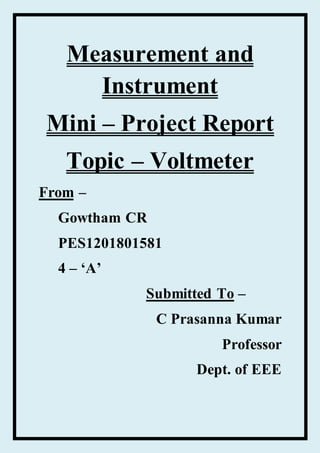
Voltmeter - Measurement and Instruments
- 1. Measurement and Instrument Mini – Project Report Topic – Voltmeter From – Gowtham CR PES1201801581 4 – ‘A’ Submitted To – C Prasanna Kumar Professor Dept. of EEE
- 2. Objective – 1. To understand the use and operation of the Voltmeter. 2. To know all different types of Voltmeter and their Operation. Introduction – The German physicist, Georg Ohm, was the first to explore the relationship between the current through an object compared to the voltage applied across that object. He published his results, Die galvanische Kette, mathematisch bearbeitet, in 1827. His results were not immediately accepted, because his methods were so revolutionary, and challenged the accepted requirements of scientific reasoning of his day; science is a human endeavor, and this result has a fascinating backstory. To investigate the properties of voltage and current, and the relationship between the two, we need tools and equipment to do it. We measure voltage with the voltmeter, and current with the amp-meter or ammeter. Whatis a Meter? A meter is any device built to accurately detect and display an electrical quantity in a form readable by a human being. Usually this "readable form" is visual: motion of a pointer on a scale, a series of lights arranged to forma "bar graph," or some sort of display composed of numerical figures. In the analysis and testing of circuits, there are meters designed to accurately measure the basic quantities of voltage, current, and resistance. There are many other types of meters as well, but this experiment primarily covers the design and operation of the basic three. Most modern meters are "digital" in design, meaning that their readable display is in the form of numerical digits. Older designs of meters are mechanical in nature, using some kind of pointer device to show quantity of measurement. In either case, the principles applied in adapting a display unit to the measurement of (relatively) large quantities of voltage, current, or resistance are the same. Theory – Ohmshowed that a steady current was caused by a constant voltage, and that were directly proportional to each other, and scaled with the length of the resistive element through which the current flowed. Today, we express this relationship mathematically as V/I ∝ 1, where V is the voltage (measured in the SI systemin volts, V) and I is the current (measured in amperes, A). We give the constant of proportionality the name resistance, and the symbol R. Resistance is measured in ohms, with the symbol Ω. V = R × I Or
- 3. A voltmeter is designed to measure the voltage across a portion of a circuit, while an ammeter is designed to measure the current passing through a particular point in the circuit. That is, the voltmeter stays outside the circuit, while the ammeter must be inserted into the circuit. While these devices have distinct properties and uses, the ammeter and voltmeter are such a basic part of the scientific measurement toolkit, that they are usually found integrated into a single device called the multimeter. There are many kinds of multimeters: desktop or handheld, analogue or digital, manual or auto-ranging, low and high voltage, etc. The language of circuit schematics is highly evolved, and there are de facto standard representations of typical devices. Table 1 contains the common symbols used in this lab. When learning to build or “wire” a circuit from a schematic, it is usually best to arrange your physical devices (resistors, power supplies, meters, etc.) in the same orientation as the devices on the schematic. Then, follow the “map” given by the schematic: pick one terminal on the first device, and locate all the terminals on other devices that are connected to that terminal all the schematic. Using one or more wires, reproduce those schematic connections in the physical world. Repeat until you have “visited” all terminals on the schematic. WorkingPrincipleof Voltmeter – Its Working is based on the principle of Ohm’s law. Ohm’s law states that – “Voltage across a resistance is directly proportional to the current passing through it”. Any basic meter has a potential difference across its terminals when a full-scale current flows through it. The symbol to represent the voltmeter is a circle with an enclosed letter V.
- 4. Circuit Diagram to Represent Voltage A voltmeter is always connected in parallel to the component in a circuit for which the voltage is to be measured. A DC volt-meter has polarity signs on it. Therefore one has to connect the plus (+) terminal of the volt-meter to the higher point of potential and the minus (-) terminal to the lower point of potential in order to obtain a meter deflection. In an AC volt-meter there is no polarity signs on it and can be connected anyways. However, in this case also, the voltmeter is still connected in parallel to the component for which the voltage is measured. A volt -meter with a high voltage range is built by connecting a resistance in series with a meter mechanism that has a full scale voltage capability as shown in the below Figure. Full Scale Voltage Capability Voltage Equation – The resistance in series is called a multiplier. Its value is determined from the Voltage Equation.
- 5. Where, V = Voltage, Im = Full scale current, Rse = Resistance in Series, and Vm = Full Scale Voltage Voltage Sensitivity– Voltage Sensitivity is the reciprocal of the current necessary for full scale deflection. The smaller the meter current, the larger the voltage sensitivity will be. The actual voltmeter resistance equals the sensitivity times the complete voltage. The voltmeter resistance will always be constant even though the voltage reading may not be a full-scale reading. Symbolic Representationof Voltmeter – Voltmeter And It’s Types – The voltmeter is classified into three ways. The classification of the voltmeter is shown in the figure below.